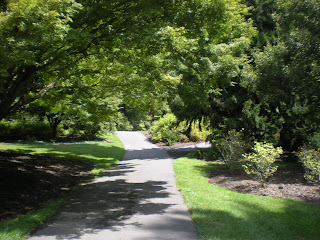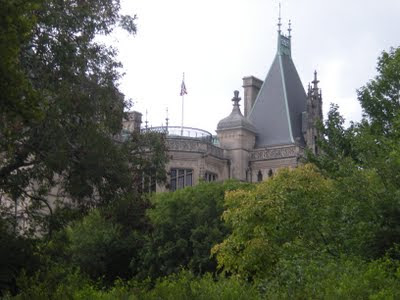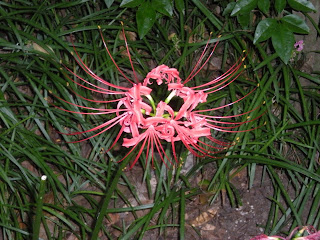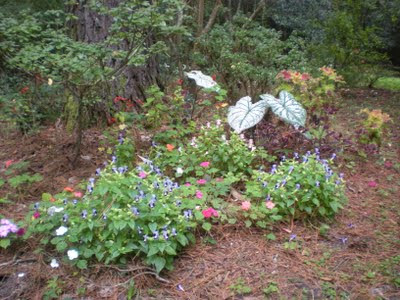I will write about this walk soon.
Thursday, October 27, 2011
Thursday, September 22, 2011
September 22, 2011 - Lansing
We started our Lansing walk in the Michigan Historical Museum and quickly arrived at the State Capitol building. The State Capitol was designed by Elijah Meyers in 1872. Myers has designed more state capitols than any other architect (he also designed capitols for Texas and Colorado). Meyers' design, with its lofty central dome and balanced wings, became a model for most statehouses built in America during the "Golden Age" of capitol construction after the Civil War. Due to a limited budget, the interior surfaces were hand painted to look like marble and walnut, and it is hard to tell they are faux.
| The Rotunda: The oculus, or "eye" of the dome provides a glimpse into the vastness of the universe, represented by a starry sky |
I got a really nice 20-page booklet about the Capitol, which was helpful during our self-guided tour of the building. The inside of the building is spectacular. The floor underneath the rotunda is made of glass and from the basement we looked up and saw schoolchildren lying on the glass floor as they gazed up 160 feet to the rotunda. The rotunda is decorated with hand-painted muses representing art, agriculture, law, science, justice, industry, commerce and education. The House and Senate Chambers were also quite beautiful. They featured coffered ceilings with hand-etched glass panes picturing the coats of arms of all 50 states.
| One of the "Michigan Chandeliers" |
| Close-up of the elk and shield design |
| Along the Grand River |
Our walk also took us past Lansing Community College and Thomas M. Cooley Law School. (We also passed the Cooley Law School Stadium, home of the Lansing Lugnuts. How many law schools have their own stadium?) We walked through Old Town and followed the River Trail along the Grand River until we came to the Lansing City Market.
| The Board of Water and Light Building |
| Michigan Women's Historical Center and Hall of Fame |
Walk Route: A-
| Cooley Gardens |
Walk Documentation: A-
Wednesday, September 21, 2011
September 21, 2011 - Zeeland
Zeeland, Michigan, is a community that is clearly very proud of itself - and with good reason! Virtually all of the homes we passed were well-kept, with tidy, attractively landscaped yards. Many of the homes bore plaques indicating the date of construction. Zeeland's inventory of lovely houses included Queen Anne, Victorian Gothic, Craftsman, Prairie, and even a few based on Frank Lloyd Wright's work - each one delightful.
 |
| The "Painted Lady" - a Queen Anne style Victorian built in 1898 |
 |
| A quintessential Craftsman home |
Zeeland, a town of around 6,000, is home to the Herman Miller furniture company and the Howard Miller Clock Company, as well as Mead Johnson (baby formula). Zeeland was founded in 1847 by Dutch settlers seeking religious freedom. The Dutch roots are still very apparent in the names on local businesses, street names, and orderly neighborhoods. We passed at least eight Dutch Reformed or Reformed churches (and one Baptist church). Diversity is not one of Zeeland's strong suits, but the town does well in all other respects..
Zeeland is a delightful community - what you would imagine Lake Woebegone to be like. The people are friendly, all of the homes are charming, the yards are neat, and the town is bedecked with banners proclaiming : "Feel the Zeel."
I must add that the route instructions were excellent. I got a nice little pamphlet that contained instructions, an excellent map, and several pages of annotations about the various buildings along the route.
Walk Route: A
Walk Documentation: A+
Thursday, September 8, 2011
September 7 - Asheville (YRE)
We had a special treat in Asheville. Two local volkswalkers met us at the start point and walked with us. Now that’s what I call Southern Hospitality!
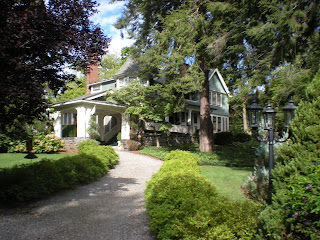 In 2011 Asheville was picked as one of the “10 Most Beautiful Places in America” by Good Morning America. Asheville, tucked away in the Blue Ridge Mountains, offers a high quality of life. It has carefully preserved much of its heritage and has avoided becoming a tourist trap.
In 2011 Asheville was picked as one of the “10 Most Beautiful Places in America” by Good Morning America. Asheville, tucked away in the Blue Ridge Mountains, offers a high quality of life. It has carefully preserved much of its heritage and has avoided becoming a tourist trap.We started our walk in the Montford Area Historic District, a neighborhood filled with Victorian era homes. From there we went through a botanical garden and part of the University of North Carolina Asheville campus.
 |
| City Hall is on the right |
We saw the home of author Thomas Wolfe and then went to the downtown core where we saw a city hall that looked like a wedding cake. Indeed, interesting architecture could be seen in all directions, particularly Art Deco. One building that was especially noteworthy was the Basilica of St. Lawrence, with its large freestanding elliptical dome.
Another important feature of the downtown area was its variety of opportunities to purchase local arts and crafts, particularly in the Grove Arcade. We saw a lot of handmade pottery and items made of wood.
Rating:
Walk Route: B+
Walk Documentation: A-
Tuesday, September 6, 2011
September 6 - Biltmore Estate (YRE)
The Biltmore Estate is one of those bucket list places I’ve always heard about, and I’m so glad I finally got a chance to visit it. It was absolutely breath taking. Sure, it is over-the-top ostentatious, but it is also a national treasure. Biltmore House is the gorgeous châteauesque home built by George Vanderbilt in 1895. No expense was spared, and no detail was too small to merit attention in this lavish mountain retreat.
I’m not going to go into a lot of detail about Biltmore House, or about the grounds, designed by Frederick Law Olmstead (but I could, and I might supplement this post after I get home). I will just say, go see it, and rent the audio tour.
Biltmore contains over 250 rooms and we toured 42 of them. Then we did a 5K volkswalk on the grounds. It was a beautiful day and it was delightful to wander through gardens and woods.
We started out on the terrace where the view of the Blue Ridge Mountains was stunning. After walking through an arbor, we walked through the Spring Garden and the Azalea Garden. The landscaping was artfully blended into the forest to create a beautiful, peaceful environment. Rustic bridges complemented the paths of the estate.
 |
| The Boat House |
At the Bass Pond, we were treated to the Boat House, a small gazebo on the edge of the water. At the other end of the pond we caught a view of a little waterfall and a pleasant natural stream.
 |
| The Conservatory |
 |
| Inside the Walled Garden |
The final part of the walk took us to the Walled Garden and the Conservatory. The conservatory is a huge hothouse with every type of tropical plant you can think of, and lots of inviting nooks to sit in. The Walled Garden was a huge formal garden with flowers, fruit trees, ornamental plants, and lots of roses. Olmstead was a genius, but we already knew that.
After our walk we went to Antler Hill Village, a newly developed area of the Biltmore Estate. We saw a fabulous exhibition of Tiffany Lamps and went to wine tasting at the winery. There wasn’t much else there.
Rating:
Walk Route: A
Walk Documentation: B-
Monday, September 5, 2011
September 5 - Columbia (YRE)
 |
| State House |
We did the 10K walk in Columbia on Labor Day. This meant there was practically no traffic. It also meant that EVERYTHING was closed: restaurants, museums, stores, even the Capitol Building.
Our walk included the State House and grounds, the University of South Carolina campus, Woodrow Wilson’s boyhood home, the Robert Mills house, the Governor’s Mansion, half a dozen other notable houses, Finlay Park, Memorial Park, and Adluh Flour Mills. All of these points of interest were closed with the exception of the two parks and the University campus.
 |
| Waterfall at Finlay Park |
There were very few people about. We didn’t see anyone on the USC campus. We saw people in only two places: a large crowd of homeless people in Finlay Park where they seemed to be having some kind of program aimed at helping homeless people and a large crowd of members of the press at the Convention Center where they were preparing for a Republican presidential candidate’s debate.
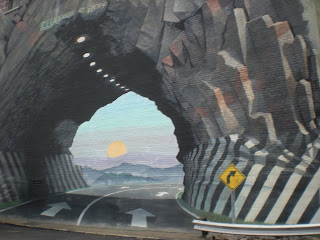 |
| "Tunnelvision," a mural by Blue Sky |
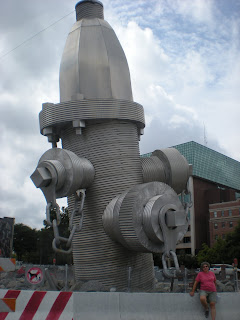 |
| Busted Plug |
When they were giving out charm and vitality, they gave so much to Savannah and Charleston that there wasn’t much left for Columbia.
The walk instructions had a nice supplement describing 23 different points of interest. There were a couple of places where the instructions were hard to follow.
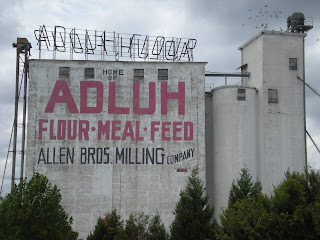 |
| Prominent Feature of the downtown skyline |
Rating:
Walk Route: C+
Walk Documentation: B-
Sunday, September 4, 2011
September 4 - Charleston: Magnolia Plantation (YRE)
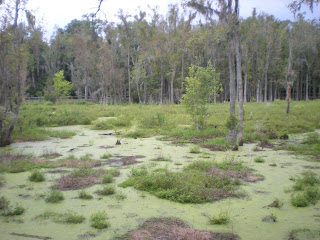 |
| The Audubon Swamp Garden |
 |
| Cypress "Knees" |
 |
| Slave Cabin |
We had to buy entrance tickets in order to do the volkswalk, and the various ticket options were confusing. We didn’t know which tickets we needed for the volkswalk, so we bought the basic ticket and that turned out ok. We also bought the Nature Boat tickets and we were able to enjoy the boat tour after our walk.
We chose the 5K walk and got to see almost everything but the the Wildlife Observation Tower and the Waterfowl Refuge. (We saw the Waterfowl Refuge on the boat tour. Our walk included, or at least passed by the entrance to, the following features:
- Barbados Tropical Garden - indoor tropical garden with many varieties of orchids
- Biblical Garden - plants mentioned in the Bible, with an Old Testament area commemorating the twelve tribes of Israel, and New Testament area representing the twelve disciples
- Camellia Collection - First Camellia japonica plantings date from the 1820s, with current plantings containing nearly 900 varieties, of which almost 150 originated from the gardens' own nursery
- Cattail Wildlife Refuge
- Cypress Lake - Bald cypress trees, up to 100 years old, along riverbanks and wetlands.
- Flowerdale (50 acres) - Oldest sections established 1680. Formal plantings of annuals set within triangular beds enclosed by boxwood hedges
- Long Bridge - Built in the 1840s, one of seven bridges on the grounds
- Maze - replica of England's famous Hampton Court maze
- Nature Center and Zoo - domesticated animals typical to Southern plantations, injured or orphaned native animals, and exotic birds including Malayan jungle fowl, guinea hens, and peacocks
- The Audubon Swamp Garden
- Slave cabins
- A very old cemetery
- A barge used long ago to transport goods to Charleston. (Because the Ashley River is tidal in this area, it was possible, with careful timing, to take the 3 ½ hour barge trip in both directions!)
- Plantation House - Oldest section built prior to the Revolutionary War near Summerville, SC, and transported down the Ashley River after the Civil War. The wide verandah and huge columns are a fairly recent addition.

 |
| The Old Cemetery |
 |
| Gator! |
We saw some turtles and alligators in the Audubon Swamp and we saw a number of interesting birds on the boat tour, including egrets, herons, wood ducks, ibis, and anhinga. There were several ancient live oak trees on the property, as well as fresh water lakes and salt marshes.
The gardens, with the exception of “Flowerdale,” were not the formal type of gardens I was expecting. It was more like someone had planted flowers and ornamental plants (such as coleus) here and there in the woods. It was a nice change from the typical botanical garden. It probably would be best to go earlier in the year when more flowers are in bloom.
We “forgot” to go to the orientation film, and I am sorry to have missed it. The ticket seller did not mention it and there wasn’t any prominent signage directing new arrivals towards it. It might be a good idea to include it in the walk instructions as the first step in the volkswalk.
 |
| The Plantation House |
The gift shop at the Plantation House was delightful. It was several notches above the usual tourist trap. In fact, the Magnolia Plantation and Gardens overall did a very good job of maintaining authenticity and avoiding Disneyfication.
Saturday, September 3, 2011
September 3, 2011 - Charleston (YRE)
Charleston was established in 1670 by English settlers from Bermuda. In Colonial times, Charleston was an important hub for trade in deerskin, rice and indigo.
The first thing we came to on our walk was a farmer’s market. It was very crowded, but in a good way that said “This is the place to be.” There was food to take home, such as handmade raw pasta, honey, jam, local cheese and fresh eggs. There was also food to eat right there, including doughnuts (cooked right in front of you), crepes, and gyros. The non-food items also looked very interesting. I assume this is something you can only enjoy on Saturdays.
We proceeded to the campus of the College of Charleston. Founded in 1770, the campus has many historic buildings and is quite beautiful. The enrollment is about 10,000. Perhaps As a result of the presence of so many students, this section of Charleston is lively and full of shops and restaurants.
 |
| On the campus of the College of Charleston |
 |
| Cobblestone street |
 |
| Cathedral of St. John the Baptist |
The historic downtown area also contains many striking examples of museums and other public buildings, and especially, churches. In fact, Charleston is known as the Holy City due to the prominence of churches on the low-rise cityscape, particularly the numerous steeples which dot the city's skyline, and because it was one of the few cities in the original thirteen colonies to offer religious tolerance, albeit restricted to non-Catholics.
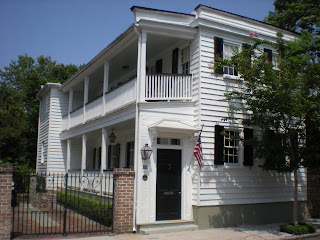 |
| Door provides access to the veranda |


At the tip of the Charleston peninsula, we arrived at White Point Gardens. I would not have called this a garden. It contained some trees, but no flowers or shrubbery. It also contained various cannons and other military relics. From here you could walk along the river to a point from which you could view Fort Sumter.
 |
| Pineapple fountain at Waterfront Park |
At this point, we had reached the oldest part of Charleston. It included the Old Slave Mart, a theater dating back to 1736, and some more churches. Next up was the City Market, established in 1788. Once an actual market for meat and other staples, it is now a three-block long market that is full of t-shirts, cheap jewelry, and other imported junk. It was jam-packed with tourists. Why would you buy a Russian nesting doll or a knock-off purse from China as a memento of your visit to Charleston?
 |
| Dock Street Theater |
A few more old houses, a few more old churches, another cobblestone street, and we were back at the Visitor’s Center after a very long day. Be sure to allow plenty of time for this walk.

By the way, Charleston was the first city in the US to establish Livability Court. A Livability Court is a municipal court focused on cases involving non-compliance with codes and standards about housing, waste, the environment, noise, animal control, zoning, traffic and tourism.
Rating:
Walk Route: A
Walk Documentation: A
Subscribe to:
Posts (Atom)





